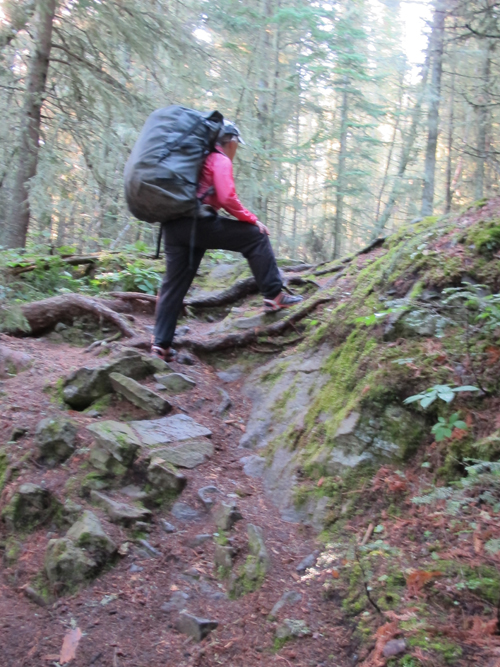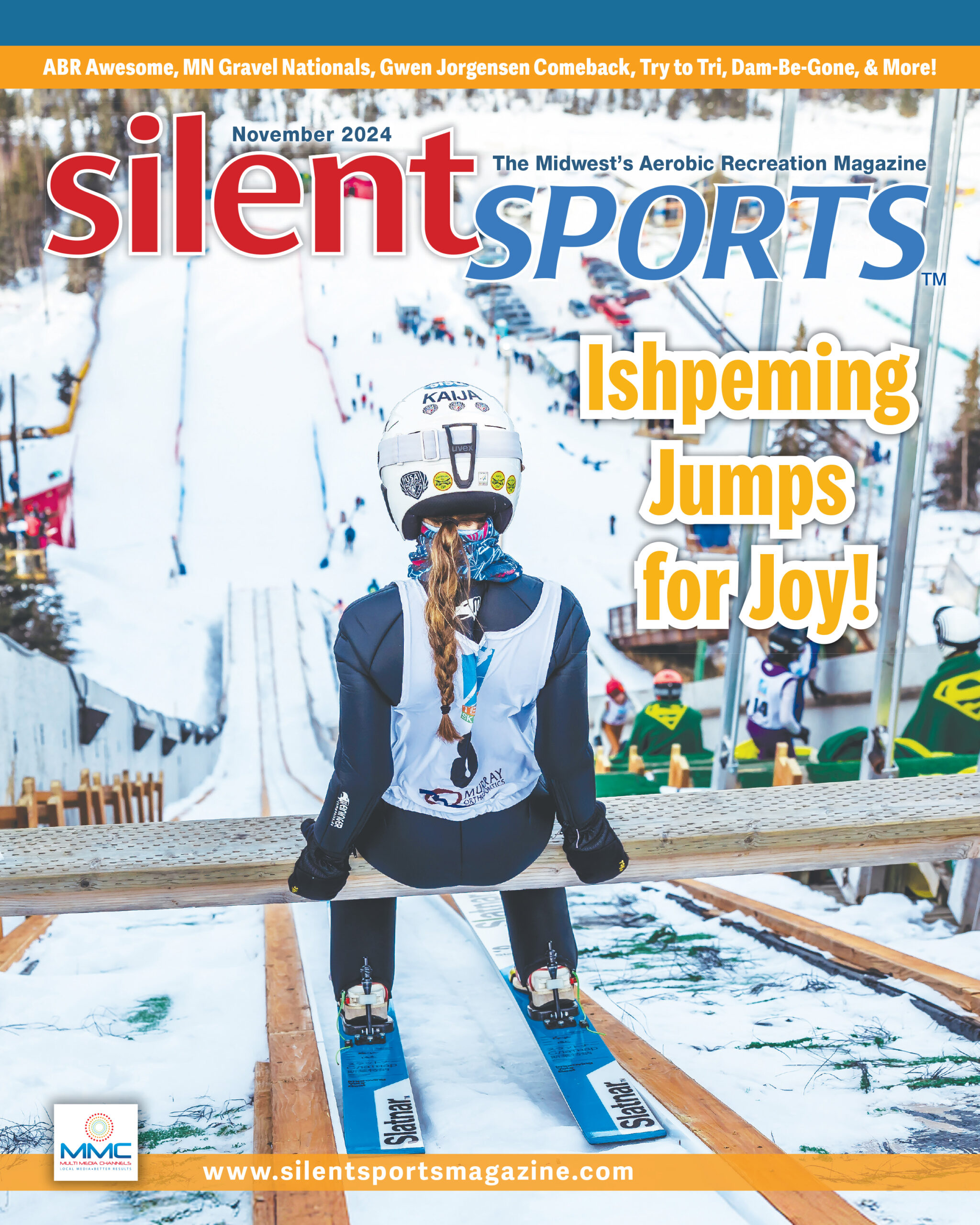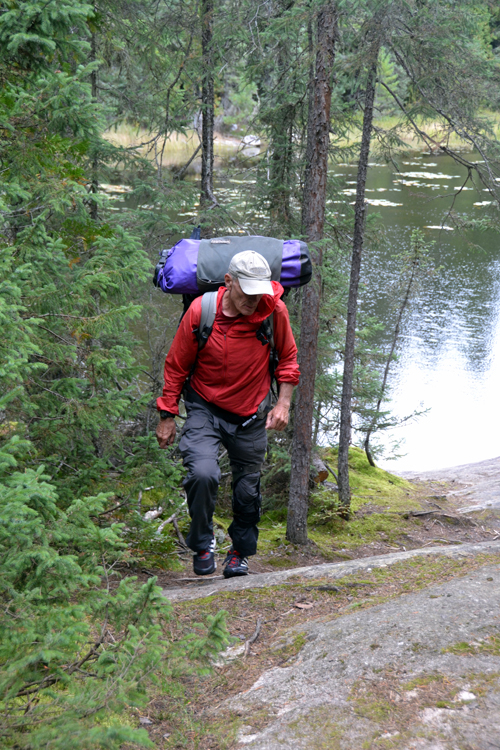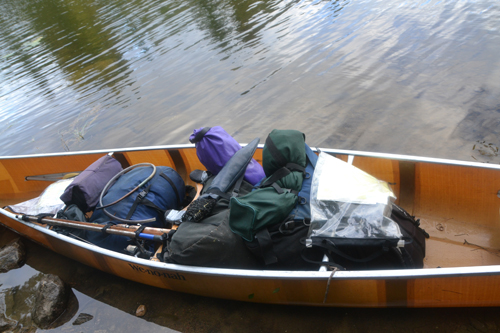Canoe camping tips

To save time and ease frustration
By Dave Foley
Back country camping can be tough.
It rains. Fires won’t start. You lose stuff and can’t find items you know you packed. In fifty years of wilderness travels, I’m familiar with all these annoyances and I’ve figured out how to minimize some of the unpleasantness.
Let’s start with rain. It’s inevitable on most trips. Have your rain gear handy, that’s a no-brainer. On a canoe trip mine is in a day pack. The problem was that sitting in the bottom of the canoe the pack would get wet, soaking my rain gear. Putting on a wet raincoat over a dry shirt is counterproductive. It finally occurred to me to stuff my rain jacket and pants into a Ziploc bag so even if the back pack was immersed in water, the rain gear would be dry when I put it on.
The day pack that carries my rain gear also holds all the stuff I’ll need while we’re on the move – insect repellent, sunscreen, snacks and lunch. By keeping essentials close at hand, I won’t have to open our main packs during the day. Inside the portage pack on top is the tarp and first aid kit, so if it’s raining when we get to camp or there is an emergency, I extract these items and minimize the amount of moisture that will drop into the pack.
At first we carried our Therm-a-Rest and Ensolite sleeping pads strapped to the outside of our packs. By the end of the day invariably they were wet and often muddy. Then we put them in plastic bags. The results were better but the plastic was easily torn. At this point it occurred to me to put the pads in plastic bags and then slide them into those narrow nylon bags that are used to store collapsible camping chairs. Problem solved. The pads are still strapped onto the packs but now they stay clean and dry.
Under wet conditions, starting a fire can be problematic. To meet the challenge, I’m carrying nature’s premier fire starter – a few pieces of birch bark in a plastic bag. In addition, I have a fire tube. Although commercial ones are available, I made one using a foot long piece of copper tubing which I shoved into a three foot piece of flexible plastic tube and then hammered the metal end partially flat. By blowing puffs of air through this, a smoldering fire will become a blaze. With the birch bark and the tube, as well as splitting wood to expose the dry interior and collecting dead branches at the base of conifers, fires can be started even when the land is drenched.
Hands-free?
If I could, I would only carry backpacks and canoes down portage trails; my hands would be free. That’s never going to happen, but over time I’ve figured out how to simplify and minimize the loose gear we carry in our hands. When we portage, my wife Cyndy and I have three large gear packs to transport as well as a small day pack that the canoe carrier wears and a fanny pack that is worn on the front when one is carrying a large pack.
That leaves only three paddles, the camera, fishing rods and a painter pole as hand items. The PFDs are snapped onto the canoe seats. Maps used to be a problem. Secured in plastic cases, I used to shove them up under the bow and stern plates of the canoe, but occasionally they would fall off on the portage trail. That issue was resolved when I looped the painter ropes through the grommets in the map case and then made sure both ends of the painter rope were tied onto the canoe. Now if a map becomes dislodged from the bow or stern plate, instead of hitting the ground it stays with the canoe on the rope. The painter ropes also insure that the wind won’t blow a map out of the canoe when we’re paddling.
I know some folks tuck their paddles up under the canoe for portages, but we prefer to carry ours in hand. Bent shaft carbon fiber paddles are more fragile than wood or plastic ones and they might not fare so well riding under our canoe as I have been known to trip and then drop the canoe. The paddles, especially if the canoe hits the ground, might become dislodged and get broken. If I’m carrying them while walking and I start to fall, I flip the paddles into the brush where they are unlikely to be damaged. Last summer, I tripped on a portage and hit the ground hard while the paddles sailed safely into the bushes.
The camera, a bulky Nikon SLR, is another hand item. Although I could fit it into the pack, I like to keep it handy as some of my best photo opportunities occur on portage trails. A sturdy nylon case protects the camera, which is stuffed into a small waterproof Seal bag.
A painter pole goes along on our trips as it has proved invaluable as either a corner support on a tarp or used – with its end covered with an oven mitt – to lift the center of the tarp.
I carry two spinning rods, which used to be a major headache on the portages as the lures would catch on trees and the line was forever getting snagged. I finally gave up on fishing during travel days, except occasionally during a lunch stop. That ended the problems with snagged lures and line getting caught on brush, but the rod tips were still vulnerable. The solution I discovered was to break down the rods, leave the reels on the rods but with no loose line, then lay the yardstick – which serves as my fish measurer – and the painter pole next to the rods so that the end of the painter pole or yardstick protects the rod tip by extending beyond it. I then secure the rods, yardstick, and painter pole together into a single bundle with three Velcro strips.
Another item, which often needs to be carried by hand, is a landing net. A standard hoop net is a brush catcher. Especially if the trail is narrow, the net will seem to grab onto all manner of vegetation. For back-country tripping, a fisherman needs a collapsible net. After collapsing the net, wrap the mesh and cover it with a plastic bag. This package can be shoved under straps on a portage pack. The net I used last year had a leather case to contain the mesh and it fit easily under pack straps.
“I know I packed it, I just can’t find it.”
This was the dilemma I faced in earlier years. I would root around in packs, pulling stuff out and peeking into bags frustrated that the location of the desired item was eluding me. Eventually my wife Cyndy and I developed a system to solve this problem. With our three packs, each of us has one for our clothing; the third pack contains camp gear and the food is split between all packs. Rather than a single stuff bag containing all our clothes, we use several of different colors – for example pants in the gray bag, upper body coverings in the red bag, small items like gloves, hats, socks in the purple bag and personal items like books, toiletries, journal, headlamp in the black bag. In addition, each of us carries a pillow case which we fill up with clothes creating a pillow.
Cyndy uses the bag system for packing food. At the start of the trip she might have 20 bags of various colors. To keep track of the contents, she writes that information with a waterproof pen on a piece of cardboard. She then places the cardboard in a Ziploc. The smaller food bags easily fit in a pack and when we’re cooking, time isn’t wasted rooting around looking for needed ingredients.
When we’re out touring the BWCA or the Quetico, we know there’s nothing we can do about the weather, and portage trails are what they are, but the way we do our camping, that’s a different story. The ideas presented here have made our trips a little more enjoyable. We hope there’s something here that will help you as well.





